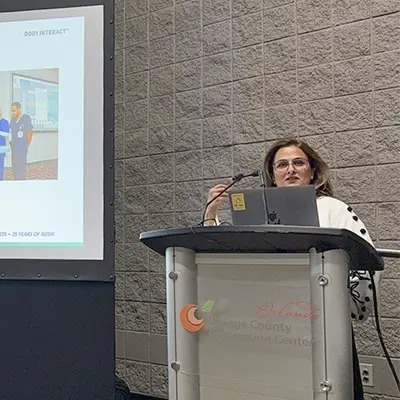Simtegration – St. Luke's Medical Center College of Medicine Success Story
St. Luke’s Medical Center College of Medicine-William H. Quasha Memorial (SLMCCM-WHQM) successfully conducted its first two Simtegration sessions through collaboration between the Department of Surgery and the Center for Innovations. Year level 5 medical students who were rotating in the Department of Surgery at that time actively and enthusiastically participated in the Virtual Patient component of the Simtegration activity. This innovative experience allowed them to apply theoretical knowledge to practical situations, improving their clinical skills and decision-making abilities. The selected case for this pilot activity was a 47-year-old male presenting with bleeding hemorrhoids, a common medical issue that the students may encounter in their future medical practice.
Body Interact Simtegration Set-up
The examination room for the activity was set up with a manikin task trainer and a laptop. A printed copy of the case history was placed on the table for the students’ reference. The participants consisted of two medical doctors and a medical student. One medical doctor served as the Body Interact Controller, facilitating the Simtegration and navigating the laptop, while the other medical doctor acted as the evaluator. The medical student then took the oral exam accordingly.

Simtegration Proper
During the actual Simtegration session, the medical student was instructed to enter the examination room. Subsequently, the student was given ample time to review the clinical history of the Virtual Patient / Body Interact case.

Once the student has gathered his or her thoughts and prepared, he or she enumerates the questions to ask the Virtual Patient. Afterwards, the Body Interact software displays all the questions at the Dialogues section on the screen.


When the medical student had no further questions or need for clarification, the Body Interact Controller proceeded to inquire about the specific focused physical examination the medical student planned to conduct on the Virtual Patient. The examinee then articulated the steps they intended to perform on the Virtual Patient.
Following that, the Body Interact Controller displayed all the procedures outlined in the Physical Examination Tab of the Software. The medical student then proceeded to conduct an actual digital rectal exam on the manikin, providing a comprehensive narrative on the procedure. Furthermore, the student was required to verbally communicate the findings after completing the examination. The Body Interact software was utilized to present the actual examination findings to the examinee.

The final segment of the activity entailed recording the initial diagnosis and management plan on paper. The examinee was also required to communicate their working impression and plan to both the evaluator and the Body Interact Controller. Each examinee was allotted a total of 12 minutes for the entire session.
Conducting the Simtegration activity for Year level 5 medical students facilitated the enhancement of clinical thinking and decision-making skills in accordance with latest national guidelines. Additionally, it provided students with an immersive simulation, allowing for the practical application of psychomotor skills learned.
Student feedback
Following the activity, a brief survey was administered, yielding highly positive feedback. The students not only enjoyed the experience but also perceived it as a realistic representation of an actual case involving bleeding hemorrhoids.
Given the positive outcomes of the activity, SLMCCM-WHQM eagerly anticipates conducting the Simtegration activity with the upcoming cohort of Year level 5 medical students. Future initiatives involve broadening the scope of this valuable resource and simulation experience to include other departments and academic levels within the institution.

Conclusion
Thanks to Dr. Genevieve Padilla-Evangelista, Dr. Romualdo Cacas Jr., Dr. Gilmyr Jude Maranon, Dr. Edgar Cabrera, Dr. John Dave Omolida, and Dr. Adolfo Manalaysay III of the Department of Surgery, as well as Dr. Redante Mendoza and Dr. Athena Awayan-Lat of the Center for Innovations, for generously sharing their expertise with the entire Body Interact Community. We eagerly anticipate future collaborations and outcomes with SLMCCM-WHQM.









